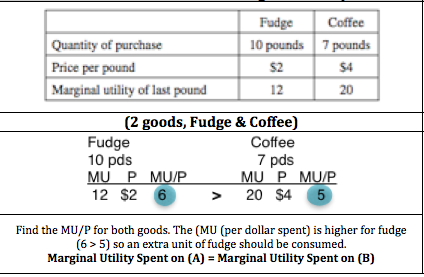2008 Micro FRQ #2
(A) Define marginal utility - satisfaction from consuming an additional unit.
From the PPC & Utility Cheat Sheet Here.
(B) The table below shows the quantities, prices, and marginal utilities of two goods, fudge and coffee, which Mandy purchases.
Mandy spends all of her money and buys only two goods. In order to maximise her utility, should Mandy purchase more fudge and less coffee, purchase more coffee and less fudge, or maintain her current consumption? Explain.
It is important that you recognise that the formula helps to set these two goods equal. If the utility of both goods were 12 but the cost of one was $2 and the other $4, then it wouldn't be a fair comparison as one good costs twice as much as the other. We use the formula (below) to take into account the differing marginal utilities and the price difference between goods.
Understand (memorize) the Formula for these Utility problems.
(C) Assume that consumers buy 20 units of Good R each month regardless of price.
So, step back a second and remember what you have learned from the Elasticity section of this course. What type of goods are bought no matter the price. Two examples.
 |
| Drugs and Insulin - Perfectly Inelastic |
(i) What is the numerical value of the price elasticity of demand for good R?
Elasticity Cheat Sheet Here.
Remember that elasticity is not slope, but price changes do not effect the Qd.
No % change in Qd.
(ii) If the government imposes a $2 per-unit tax on Good R, how much of the tax will the seller pay?
Buyers will pay the total amount of the tax.










